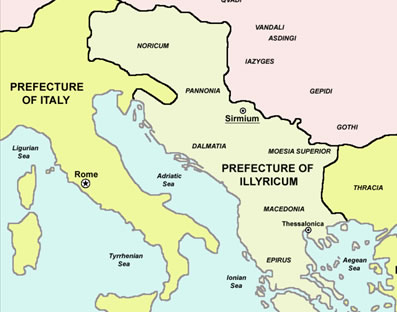CH101 - The Fourth Century
The Church Established, 303 - 400 A.D.Outline
Diocletian and Church Growth
The "Great" Persecution under Diocletian
Constantine becomes the Emperor
Initial Heresies (Donatus - Arius)
The Faith of Constantine
The Council of Nicea, 325AD
The Nicean Creed
Post-Nicean History
Christianity - Post Nicea
These pages are coming soon:
- Fourth Century Orthodoxy
- Death of Constantine
- Julian the Apostate
- Jovian-Valentinian and Valens
- Christianity becomes the Official Religion
The Church Continues to Grow
Throughout the second half of the third century Christianity grew in almost all sectors of the Roman Empire. We have records (letters and notes from regional councils) of increasing numbers of regional bishops which speak of numerical growth; there are also a few non-antagonistic references to Christians in Roman governmental letters which speak to growing Christian influence (Christians were serving in the military and in local governmental positions).
While it is true that Christianity was growing, it was not spreading as rapidly as some Church leaders (or Roman critics) wanted to think. It is true that Christianity had some presence in Britany and in Gaul, but there was very little gospel penetration into what is now central and northern Europe.
We also know very few details of the Church in the last 30 years of the third century - we have few writings of substance which seems to indicate that there were few great leaders as has been seen during other previous periods. But we do know that the Roman Empire suffered during this period.
From around 240 until the reign of Diocletian which began in 284, it looked like the empire might dissolve. There was a succession of violent imperial changes as men killed each other and plotted to take leadership from one another. Although this is not completely different with "normal" Roman turnover of emperors, this period was especially chaotic. With poor imperial leadership came other problems: with a turnover of emperors came higher taxation and a lowering of the value of coinage (the currency that fueled the economy) - in other words, inflation.
Until the fourth century Roman generals had been able to defend the borders against the constant threat of barbarian attack, but during the second half of the fourth century the barbarians had developed into a more mobile opponent. Constant raids along the borders and inflation had forced many subsistance farmers to give up the land and move to the cities in search of a more secure life. The economic distress was beginning to threaten the very existence of the empire. Added to this economic stress, a severe plague hit in the Roman empire in the middle of the fourth century: the population of young men was affected and thus there was not enough manpower to supply the Roman legends.
In the larger cities the wealthy would typically pay for pagan temples and festivals. This was done to encourage the populace to worship since it was thought that worship of the gods enabled the Roman society to prosper. During economic hard times the wealthy did not have the capital and pagan worship suffered. There was a general sense of a growing spiritual crisis.
 The Roman Tetrarchy
The Roman Tetrarchy
In 284 Diocletian was promoted to Augustus after defeating other emperor seeking generals. Diocletian was in a strong line of soldier-general-emperors that had grown up in the Illyricum region. Diocletian quickly moved to established a new leadership scheme: an Augustus with a Caesar serving under him. He promoted Maximian to serve with him as Caesar. In 293 after another round of internal battles for leadership, Diocletian moved to the next phase of reform: there would be an Augustus on both sides of the empire with a Caesar serving under him. Maximian was named Augustus in west with Constantius, another great Illyrian general who had supported Diocletian with troops, was promoted to serve as the western Caesar. Diocletian selected Galerius, another Illyrian general to serve as Caesar in the east. Diocletian also took Constantine into his camp, the son of his western Caesar. Diocletian wanted to be involved in the training of Constantine (already serving in military leadership).
While the Roman empire struggled, the Christian Church seems to have continued to grow. The number of bishops had multiplied (indicating numerical growth and geographical reach), church buildings had begun to be purchased or built in larger cities, and Christians were found serving in governmental positions and in the military. (Eusebius, EH 8.1)
By the late 290's the Tetrarchy had secured the borders and established peace in the empire. Diocletian was pushing for religious renewal among the populace, thus he promoted worship of the various pagan deities. The Christians and a few other mystery cults would not submit to worship of the Roman gods.
This angered Diocletian - he wanted to force public worship on the Christians.
We know from Lactantius that Diocletian had Christians in his service just before he began his worst persecution. These attendants made the sign of the cross while fortune tellers were trying to divine the future for the emperor, thus causing the soothsayers difficulty. Diocletian demanded that these Christians be whipped. He also sent orders to his commanders that all Christians serving in the military be made to offer sacrifices or be dismissed from service. (Lactantius - Of The Manner in Which the Persecutors Died 10.6)

Questions, Comments or Criticisms:
You can send an email to directly to me Al Baker, CH101.
CH101 retains the right to edit and post comments/questions unless you specifically ask that your comments NOT be posted. Comments that are personal or private are never posted...only questions about Church History, the Bible, etc.
top of page |
go to page 3 - Persecution under Diocletian
![]()
ist Century Church History
The conversion of the apostle Paul
Early Church History of Galatians
James Just brother of Jesus in the Bible
1st Century Christian Church Struggles
Christian History - conversion Apostle Paul
Palestine - Philo, Josephus, Strabo, Aristotle
Apollos NT Hebrews in Ancient Rome
Apollos NT Hebrews in the Bible
Wine in Bible Alcoholic?
James the Just and Jesus in the Bible
The Apostolic Fathers
Ignatius of Antioch - Barnabas
The Shepherd of Hermas - Polycarp
Gnostics and Gnosticism - Marcion
Justin Martyr - Ireneaus of Lyons
Spirit of Martyrs - Second Repentance
Clement of Alexandria - Paidagogus-Stromateis
The New Testament Canon
The Apostles Creed and the Roman Creed
Second Century Apologists
New Testament Canon - 3rd Century
Severan Persecution - Clement, Origen of Alexandria
Origenist Controversy - First Principles - De Principii
Roman Persecution under Decian
Cyprian of Carthage North Africa
New Testament Canon - 3rd Century
Emperor Valerian Persecution
De Lapsis, On the Lapsed by Cyprian
Diocletian Tetrarchy - Church Growth
The Great Persecution of the Church
Constantine Becomes the Emperor
4th Century Heretics - Donatus and Arius
Constantine's Conversion and Christian Faith
The Council of Nicea 325AD
The Nicene Creed - Homoousias and Orthodoxy
The New Nicene Orthodoxy and Conflict
The Death of Constantine - Julian the Apostate
Jovian - Valentinian I and Valens
Christianity Official Religion - Edict of Thessalonika
docs HF